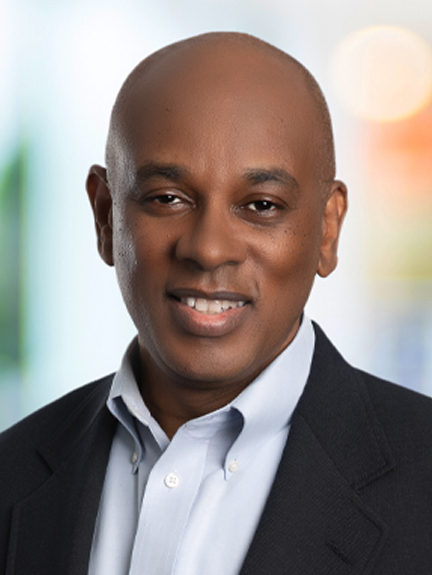Jason Harrell, DTCC Managing Director, Operational & Technology Risk and Head of External Engagement, and Phil Anderson, DTCC Executive Director, D&I, CSR, ESG Reporting and Organizational Development, discussed the benefits of professional networking during their “The Art & Science of Getting into the Right Door” panel at the 2023 HBCU Alumni Professional Development Symposium in Washington D.C.
They sat down with DTCC Connection after the event to share insights on the importance of networking and how building effective networks can help you succeed.
DC: What do you look for in a person before you add them to your network?
PA: They must be authentic. I am a servant leader and I always try to find the good in everyone. If I can help that person advance their mission or journey, then I’ll do that. It doesn't have to necessarily be for me or for my company.
JH: Their energy. I know that sounds very loose but the energy a person brings to the conversation can make you either feel comfortable or uncomfortable in that space. The second thing would be to have an interesting story. It could be something that happened during the day or an observation that you have in the moment just make it compelling.
DC: During the panel, you talked about concentric circles for networking. Can you explain this concept?
 Phil Anderson, DTCC Executive Director, D&I, CSR, ESG Reporting and Organizational Development
Phil Anderson, DTCC Executive Director, D&I, CSR, ESG Reporting and Organizational Development
PA: Concentric circles in networking simply means that each level of your network requires varying levels of attention. For example, the people who are the closest to you, some folks call it their boardroom or their board members, are part of your inner circle. And they help guide you through the most important or complex events or situations. They may be people that you trust with more personal or sensitive information. From there the outer circles are less like the inner circle and have a looser affiliation, may have more people in it but should get the same level of attention as your inner circle. However, the concentric circles are dynamic and people can move in and out of each level.
 Jason Harrell, DTCC Managing Director, Operational & Technology Risk and Head of External Engagement
Jason Harrell, DTCC Managing Director, Operational & Technology Risk and Head of External Engagement
DC: The concept of ‘relationship currency’ was discussed during your panel. What is this and what does it mean to you?
JH: Relationship currency is the value acquired from the relationships that an individual has invested in over time. We all have some level of relationship currency, and we should understand how and when to use that currency. Relationship currency can help you find your next job or role. In my current role, relationship currency is the value derived from the connective tissue that I have between financial trade associations, financial authorities, and peer financial institutions.
DC: How do you view relationship building?
JH: I view it very methodically, but it is a bit of art and science. So, to give an example, I have an event that’s coming up where the attendees are comprised of finance experts and authorities, industry peers and other officials. Since I receive a list of attendees ahead of the meeting, I go through the list and highlight the individuals and groups where I have no relationship. This part is more of the science. From there, I identify those individuals that I need to target in order to build a relationship with and utilize different networking strategies to initiate that engagement. That part is more art.
PA: I view relationship building as organic, but you must be open. Sometimes I will attend conferences without the intent to foster relationships, but I am quickly reminded that sometimes you aren’t even aware what an interaction may produce. And sometimes the result is something that you weren’t even aware that you needed. So always be prepared to pivot whenever the opportunity presents itself.
DC: What are the most valuable lessons you’ve learned from networking with executives and how have they influenced your professional growth?
JH: I would say one of the most valuable lessons I’ve learned in networking is don’t burn bridges. It is usually not necessary. You never know where people are going to land. Just because they have a role that may not be of great significance today, does not mean they won't hold a role of great significance tomorrow.
The other thing that I’ve learned is some networking tactics. When I first started in my current role, I would go to conferences where I knew 1 or 2 people. The remainder of the room was a sea of faces. For me, these situations were intimidating. So, I made a plan to not leave the room until I met 4 or 5 people. That made the situation less intimidating by essentially cutting down the room.
PA: What I do is to look for a connecting point. Particularly when I’m in their office. I look for a connecting point to start a conversation. Maybe a photo on their desk or diploma on their wall or a pin or piece of jewelry that they are wearing. However, it must be genuine. It can’t be something you're making up or pretending because they will sense that you are being disingenuous.
DC: How would you build connections and manifest a desired outcome in an unfamiliar setting?
JH: Unfamiliar settings are tough and, for many people, create feelings of anxiety. People, in general, gravitate to the familiar which is why people tend to socialize with colleagues in these situations. In addition to rescoping the room to 4 -5 people, I have also developed an elevator pitch for who I am and practiced it.
PA: One thing I want to point out which Jason alluded to earlier, is the elevator pitch. You should have a two-minute introductory pitch that summarizes your experience and aspirations equally and practice it, so it becomes natural. You will also want to modify it depending on your audience. Most importantly though, the pitch should properly represent you and give the listener a pathway in which to offer help.
< Return to Life at DTCC